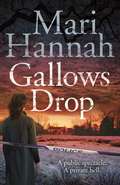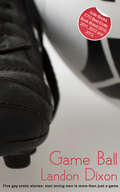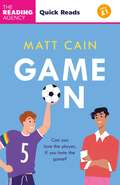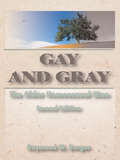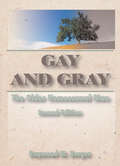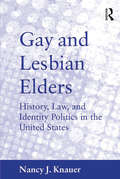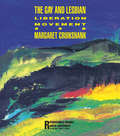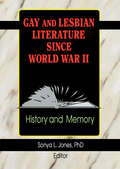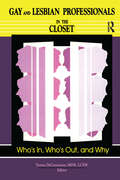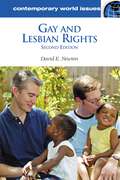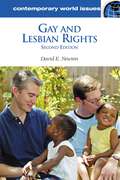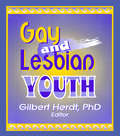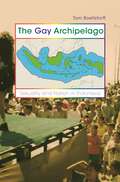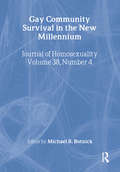- Table View
- List View
Gallows Drop (Kate Daniels #6)
by Mari HannahGallows Drop is Maria Hannah's sixth gripping crime novel featuring DCI Kate Daniels. At dawn on a lonely stretch of road, a body is found hanging from an ancient gallows the morning after a country show. Hours earlier, DCI Kate Daniels had seen the victim alive. With her leave period imminent, she's forced to step aside when DCI James Atkins is called in to investigate. There's bad blood between them. When Kate discovers that Atkins' daughter was an eyewitness to a fight involving the victim, the two detectives lock horns and he's bumped off the case. It's the trigger for a vicious attack on Kate, exposing a secret she's kept hidden for years and unearthing an even darker one. Shaken but undeterred, Kate sets out to solve a case that has shocked a close-knit village community. As suspects emerge, she uncovers a curious historical connection with a hangman, a culture of systematic bullying, a web of deceit and a deep-seated psychosis, any one of which could be motive for murder.
Game Ball (Hot Tales of Gay Lust #10)
by Landon DixonA collection of five erotic gay stories with mixed themes from one of erotica's best known writers Landon Dixon. Stories include menage, BDSM, voyeurism, sex in public and interracial themes.Game BallHe was still upset with himself half an hour after the game. He'd missed the tying goal with three seconds left. But his team-mate, Octavio, knew the score, the big, rugged, raven-haired, copper-skinned guy offering up a post-match pep session that turned losing into winning, gloomy into gaiety. Game on!PulpedBryan Frinkle loves comic books, graphic novels, and all things Yaoi. But most and best of all, he loves pulps, the rough paper fiction magazines that dominated newsstands in the 1920s, 30s, and 40s. His favourites are the hero pulps, whose rugged, wily, earth-shaking, heartbreaking leading men often find their way straight into young Bryan's very active fantasies. And when he ventures forth to the pulp magazine and paperback book convention, he meets a couple of young men who share his passion - and passions. Even the garish pulps never dished out thrills so lurid!Men of the Open RoadThe road he walked, he didn't walk alone. With his thumb out, dressed in a tight white T-shirt and pair of blue jeans that showed off his smooth, young, sun-bronzed body, he kept getting picked up by older men. And taken for rides. It was the most satisfying form of travel he knew.Sunnyside UpMark wasn't exactly overjoyed when his parents suggested he spend the summer on his uncle's farm. The only consolation was that his cousin two times removed, Jake, was going to be there, and they were both around the same age. Maybe they'd have some good times. And maybe, just maybe, Mark would experience the longest, hottest summer on record.Blue vs BrownThe streets were where their war was waged, individual battles won and lost on their routes. The FedEx guy in his blue uniform, Ron. The UPS guy in his brown uniform, Don. Every now and then, though, their fire would turn downright friendly, the two hardened road warriors abandoning the uniforms that made them mortal business enemies to engage in a sizzling private truce.
Game On: Can you love the player, if you hate the game?
by Matt CainFrom the author of The Secret Life of Albert Entwistle and Becoming Ted, a brand new enemies-to-lovers romcom for fans of Ted Lasso and Red, White and Royal Blue . . .'Heart-warming and joyful' LORRAINE KELLY 'A great big hug of a book' MICHAEL BALL Toddington FC defender Tom Horrocks is never happier than when he's on the football pitch, but when it comes to love, he's hiding a big secret. Worried about his young daughter and sick father - and with his team finally in the Premier League - he avoids all media.Journalist Cosmo Roberts wants to change the world, so is angry when he's sent to a quiet northern town to cover a sport he sees as anti-gay. Then something about Tom catches his eye.Cosmo hates football. Tom hates journalists.Perhaps this time they've both met their match.'Filled with joy and strength and optimism' RUSSELL T. DAVIES'Romantic and heartbreaking and uplifting' LAURA KAYReader love Matt Cain 'Wonderfully uplifting' ⭐⭐⭐⭐⭐'Absolutely brilliant' ⭐⭐⭐⭐⭐'I loved every second of this book' ⭐⭐⭐⭐⭐
Gay and Gray: The Older Homosexual Man, Second Edition
by Raymond BergerIn the absence of accurate information, American culture has upheld a distorted view of what it means to be an older gay man. Gay and Gray is the first and only scholarly full-length treatment of older gay men in America today. It breaks the stereotype that older gay men are strange, lonely creatures and reveals that most older gay men are well-adjusted to their homosexuality and the aging process.This second edition contains four new chapters that present additional perspectives on the reality of gay aging. Dr. Minnigerode&’s study shows that older gay men do not perceive themselves as growing old faster than their heterosexual counterparts, and that forty is the age at which most gay men believe that the label “young” no longer applies--this finding led Berger and other researchers to define “older” gay men as those over forty. Pope and Schulz confirm Berger&’s finding that for most older gay men a continuation of sexual activity and sexual enjoyment is the norm. John Grube&’s paper on the interaction of older gay men with younger gay liberationists explores the cultural divide between today&’s older gay man and his younger counterpart, filling a gap left in the first edition. And a concluding chapter by Richard Friend on a theory of successful gay aging summarizes much of the current thinking about this topic. The true situation of the older homosexual male presented in Gay and Gray challenges preconceptions about what it means to be old and gay. It asserts that in most ways, older gay men are indistinguishable from other older people. Because the book portrays older gay men in a realistic and sympathetic light, it is therapeutic for the many gay men who have been burdened with society&’s negative and distorted views about them. These men may compare their own lives to those of the respondents described in the book. Gay and Gray offers younger gay men a rare glimpse into their futures and enlightens and comforts those who count older gay men among their family and friends. The conclusions drawn in the book will change people&’s perspectives and offer new ways of thinking for and about older gay men.Gay and Gray is filled with rich case histories and treats its subject with dignity and compassion. Topics of focus include: love relationships social and psychological adjustment gay community self-acceptance being ”in the closet” and ”coming out” as a gay person intergenerational attitudes popular stereotypesAs the first intensive interview and questionnaire study of gay men aged 40 and older in America, Gay and Gray examines the lives of these men in light of cultural stereotypes. Author Berger asks about the social lives of these men, their involvement in both the heterosexual and homosexual communities, their ”coming out” experiences, their attitudes about younger gays, their experiences in growing older, and their strategies for adapting to life&’s challenges. In the study, Berger reveals that, contrary to stereotypic views, most older gay men are well-integrated into social networks and lead active and generally satisfying lives. He found that few live alone; most scored as well as younger gays on measures of psychological adjustment, such as self-acceptance; many are open about their homosexuality with family, friends, and colleagues; and the most well-adjusted older gay men were integrated into a homosexual community, associated with younger gay men, and were unwilling to change their sexual orientation.
Gay and Gray: The Older Homosexual Man, Second Edition
by Raymond BergerIn the absence of accurate information, American culture has upheld a distorted view of what it means to be an older gay man. Gay and Gray is the first and only scholarly full-length treatment of older gay men in America today. It breaks the stereotype that older gay men are strange, lonely creatures and reveals that most older gay men are well-adjusted to their homosexuality and the aging process.This second edition contains four new chapters that present additional perspectives on the reality of gay aging. Dr. Minnigerode&’s study shows that older gay men do not perceive themselves as growing old faster than their heterosexual counterparts, and that forty is the age at which most gay men believe that the label “young” no longer applies--this finding led Berger and other researchers to define “older” gay men as those over forty. Pope and Schulz confirm Berger&’s finding that for most older gay men a continuation of sexual activity and sexual enjoyment is the norm. John Grube&’s paper on the interaction of older gay men with younger gay liberationists explores the cultural divide between today&’s older gay man and his younger counterpart, filling a gap left in the first edition. And a concluding chapter by Richard Friend on a theory of successful gay aging summarizes much of the current thinking about this topic. The true situation of the older homosexual male presented in Gay and Gray challenges preconceptions about what it means to be old and gay. It asserts that in most ways, older gay men are indistinguishable from other older people. Because the book portrays older gay men in a realistic and sympathetic light, it is therapeutic for the many gay men who have been burdened with society&’s negative and distorted views about them. These men may compare their own lives to those of the respondents described in the book. Gay and Gray offers younger gay men a rare glimpse into their futures and enlightens and comforts those who count older gay men among their family and friends. The conclusions drawn in the book will change people&’s perspectives and offer new ways of thinking for and about older gay men.Gay and Gray is filled with rich case histories and treats its subject with dignity and compassion. Topics of focus include: love relationships social and psychological adjustment gay community self-acceptance being ”in the closet” and ”coming out” as a gay person intergenerational attitudes popular stereotypesAs the first intensive interview and questionnaire study of gay men aged 40 and older in America, Gay and Gray examines the lives of these men in light of cultural stereotypes. Author Berger asks about the social lives of these men, their involvement in both the heterosexual and homosexual communities, their ”coming out” experiences, their attitudes about younger gays, their experiences in growing older, and their strategies for adapting to life&’s challenges. In the study, Berger reveals that, contrary to stereotypic views, most older gay men are well-integrated into social networks and lead active and generally satisfying lives. He found that few live alone; most scored as well as younger gays on measures of psychological adjustment, such as self-acceptance; many are open about their homosexuality with family, friends, and colleagues; and the most well-adjusted older gay men were integrated into a homosexual community, associated with younger gay men, and were unwilling to change their sexual orientation.
Gay and Lesbian Activism in the Republic of Ireland, 1973-93
by Patrick McDonaghThis thematically-arranged study traces the emergence of visible gay and lesbian communities across the Republic of Ireland and their impact on public perceptions of homosexuality. Along the way it explores the critical and hidden activism of lesbian women, the role of rural provincial activists, the importance of interactions with international gay and lesbian organisations and the extent to which HIV and AIDS impacted the gay rights campaign. Gay and Lesbian Activism in the Republic of Ireland, 1973-93 focuses in particular on activists' efforts to engage with the different religious organisations in Ireland, the Trade Union movement, Irish political parties and the media, and how these efforts in turn shaped the strategies and activities of gay and lesbian organisations. McDonagh argues that gay and lesbian activists mounted an effective campaign to improve both the legal and social climate for Ireland's gay and lesbian citizens. In doing so, gay and lesbian individuals were important agents of social and political change in the Republic of Ireland in the period from the 1970s to the early 1990s, particularly in relation to Irish sexual mores. The book also helps to contextualise the changes in perceptions of homosexuality that have taken place in recent years and encourages scholars of Irish history to further explore the contribution of Ireland's LGBTQ+ community in transforming Irish society in the 20th and 21st centuries.
Gay and Lesbian Activism in the Republic of Ireland, 1973-93
by Patrick McDonaghThis thematically-arranged study traces the emergence of visible gay and lesbian communities across the Republic of Ireland and their impact on public perceptions of homosexuality. Along the way it explores the critical and hidden activism of lesbian women, the role of rural provincial activists, the importance of interactions with international gay and lesbian organisations and the extent to which HIV and AIDS impacted the gay rights campaign. Gay and Lesbian Activism in the Republic of Ireland, 1973-93 focuses in particular on activists' efforts to engage with the different religious organisations in Ireland, the Trade Union movement, Irish political parties and the media, and how these efforts in turn shaped the strategies and activities of gay and lesbian organisations. McDonagh argues that gay and lesbian activists mounted an effective campaign to improve both the legal and social climate for Ireland's gay and lesbian citizens. In doing so, gay and lesbian individuals were important agents of social and political change in the Republic of Ireland in the period from the 1970s to the early 1990s, particularly in relation to Irish sexual mores. The book also helps to contextualise the changes in perceptions of homosexuality that have taken place in recent years and encourages scholars of Irish history to further explore the contribution of Ireland's LGBTQ+ community in transforming Irish society in the 20th and 21st centuries.
Gay and Lesbian Americans and Political Participation: A Reference Handbook (Political Participation in America)
by Raymond A. Smith Donald P. Haider-MarkelA groundbreaking volume surveying the contributions that gay and lesbian Americans have made to the democratic process.In 1969, when lesbian, gay, bisexual, and transgender (LGBT) people first participated as a group in the political process, they faced an imposing array of obstacles. Everything from personal rejection and violence; state anti-sodomy laws; exclusion from the armed forces; and legal discrimination in employment, housing, credit, consumer service, and public accommodations.Nevertheless, by the end of the millennium, LGBT people had transformed themselves into a well-organized and begrudgingly respected political force. In the process, they dramatically changed laws and attitudes across the nation. This new volume tells the story of the rapid growth and remarkable successes of the LGBT movement—a record that makes it one of the most successful social movements in U.S. history and, ironically, the least studied.
Gay and Lesbian Elders: History, Law, and Identity Politics in the United States
by Nancy J. KnauerThe approximately two million gay and lesbian elders in the United States are an underserved and understudied population. At a time when gay men and lesbians enjoy an unprecedented degree of social acceptance and legal protection, many elders face the daily challenges of aging isolated from family, detached from the larger gay and lesbian community, and ignored by mainstream aging initiatives. Drawing on materials from law, history, and social theory, this book integrates practical proposals for reform with larger issues of sexuality and identity. Beginning with a summary of existing demographic data and offering a historical overview of pre-Stonewall views of homosexuality, author Nancy J. Knauer goes on to address the invisibility of this community. She examines the multiple double binds central to their identity formation, including ageism among gays and lesbians and homophobia among seniors. Further, the book focuses on specific legal concerns such as estate planning, housing, discrimination, and financial insecurity, and how they impact this community uniquely. Integrating theory with practical questions of policy, and advancing a new understanding of the construction of sexuality and identity, this book advocates meaningful new reforms designed to ensure equity and dignity in aging regardless of sexual orientation.
Gay and Lesbian Elders: History, Law, and Identity Politics in the United States
by Nancy J. KnauerThe approximately two million gay and lesbian elders in the United States are an underserved and understudied population. At a time when gay men and lesbians enjoy an unprecedented degree of social acceptance and legal protection, many elders face the daily challenges of aging isolated from family, detached from the larger gay and lesbian community, and ignored by mainstream aging initiatives. Drawing on materials from law, history, and social theory, this book integrates practical proposals for reform with larger issues of sexuality and identity. Beginning with a summary of existing demographic data and offering a historical overview of pre-Stonewall views of homosexuality, author Nancy J. Knauer goes on to address the invisibility of this community. She examines the multiple double binds central to their identity formation, including ageism among gays and lesbians and homophobia among seniors. Further, the book focuses on specific legal concerns such as estate planning, housing, discrimination, and financial insecurity, and how they impact this community uniquely. Integrating theory with practical questions of policy, and advancing a new understanding of the construction of sexuality and identity, this book advocates meaningful new reforms designed to ensure equity and dignity in aging regardless of sexual orientation.
The Gay and Lesbian Liberation Movement (Revolutionary Thought and Radical Movements)
by Margaret CruikshankFirst Published in 1992. Routledge is an imprint of Taylor & Francis, an informa company.
The Gay and Lesbian Liberation Movement (Revolutionary Thought and Radical Movements)
by Margaret CruikshankFirst Published in 1992. Routledge is an imprint of Taylor & Francis, an informa company.
Gay and Lesbian Literature Since World War II: History and Memory
by Sonya L JonesGay and Lesbian Literature Since World War II chronicles the multifaceted explosion of gay and lesbian writing that has taken place in the second half of the twentieth century. Encompassing a wide range of subject matter and a balance of gay and lesbian concerns, it includes work by established scholars as well as young theoreticians and archivists who have initiated new areas of investigation. The contributors’examinations of this rich literary period make it easy to view the half-century from 1948 to 1998 as the Queer Renaissance. Included in Gay and Lesbian Literature Since World War II are critical and social analyses of literary movements, novels, short fiction, periodicals, and poetry as well as a look at the challenges of establishing a repository for lesbian cultural history. Specific chapters in this groundbreaking work trace the development of gay poetry in America after World War II; examine how AIDS is represented in the first four Latino novels to deal with the subject matter; and chronicle the birth of lesbian-feminist publishing in the 1970s--showing how it created a flourishing gay literature in the 1980s and 1990s. Other chapters: outline the history of The Ladder from its initial publication in 1956 as the official vehicle of the Daughters of Bilitis to its final issue as a privately published literary magazine in 1972 examine Baldwin’s 1962 novel Another Country and discuss the complicated critical history of this work and its relation to Baldwin’s literary reputation--racial, sexual, and political factors are taken into account chart how Other Voices, Other Rooms, by Truman Capote, and The House of Breath, by William Goyen, reveal contradictory genderings of male homosexuality--suggesting an absence of a unified model of mid-twentieth-century male homosexuality argue that the 1976 novel Lover, by Bertha Harris, can be considered an exemplary novel within discussions of both postmodern fiction and lesbian theory. (The author calls for Harris to be added to the group of writers such as Wittig, Anzaldúa, Lorde, and Winterson, who are discussed within the context of a postmodern lesbian narrative.) examine the short fiction of Canadian lesbian novelist Jane Rule in an effort to shed light on lesbian creative practice in the homophobic climate of postwar North America argue for an understanding of Dale Peck’s novel Martin and John as an attempt to link two apparently different processes of import to contemporary male subjects through examination of the novel alongside selected passages from Nietzsche and Freud focus on the pragmatic issues of developing and maintaining accessible research venues from which to cultivate the study of racial and cultural diversity in lesbian lives Document the history of the Lesbian Herstory Archives, one of the first lesbian-specific collections in the world, from its birth in the early 1970s to the present.
Gay and Lesbian Literature Since World War II: History and Memory
by Sonya L JonesGay and Lesbian Literature Since World War II chronicles the multifaceted explosion of gay and lesbian writing that has taken place in the second half of the twentieth century. Encompassing a wide range of subject matter and a balance of gay and lesbian concerns, it includes work by established scholars as well as young theoreticians and archivists who have initiated new areas of investigation. The contributors’examinations of this rich literary period make it easy to view the half-century from 1948 to 1998 as the Queer Renaissance. Included in Gay and Lesbian Literature Since World War II are critical and social analyses of literary movements, novels, short fiction, periodicals, and poetry as well as a look at the challenges of establishing a repository for lesbian cultural history. Specific chapters in this groundbreaking work trace the development of gay poetry in America after World War II; examine how AIDS is represented in the first four Latino novels to deal with the subject matter; and chronicle the birth of lesbian-feminist publishing in the 1970s--showing how it created a flourishing gay literature in the 1980s and 1990s. Other chapters: outline the history of The Ladder from its initial publication in 1956 as the official vehicle of the Daughters of Bilitis to its final issue as a privately published literary magazine in 1972 examine Baldwin’s 1962 novel Another Country and discuss the complicated critical history of this work and its relation to Baldwin’s literary reputation--racial, sexual, and political factors are taken into account chart how Other Voices, Other Rooms, by Truman Capote, and The House of Breath, by William Goyen, reveal contradictory genderings of male homosexuality--suggesting an absence of a unified model of mid-twentieth-century male homosexuality argue that the 1976 novel Lover, by Bertha Harris, can be considered an exemplary novel within discussions of both postmodern fiction and lesbian theory. (The author calls for Harris to be added to the group of writers such as Wittig, Anzaldúa, Lorde, and Winterson, who are discussed within the context of a postmodern lesbian narrative.) examine the short fiction of Canadian lesbian novelist Jane Rule in an effort to shed light on lesbian creative practice in the homophobic climate of postwar North America argue for an understanding of Dale Peck’s novel Martin and John as an attempt to link two apparently different processes of import to contemporary male subjects through examination of the novel alongside selected passages from Nietzsche and Freud focus on the pragmatic issues of developing and maintaining accessible research venues from which to cultivate the study of racial and cultural diversity in lesbian lives Document the history of the Lesbian Herstory Archives, one of the first lesbian-specific collections in the world, from its birth in the early 1970s to the present.
Gay and Lesbian Professionals in the Closet: Who's In, Who's Out, and Why
by Teresa DecrescenzoThe closet takes its toll on its dwellers through their experiences of isolation, fear, paranoia, potentially increased internalized homophobia, and dissonance between role and identity; yet many people in the helping professions do not feel that it is desirable or even appropriate to disclose their sexual orientation to those receiving help. Gay and Lesbian Professionals in the Closet explores the different positions people take on this provocative issue, the arguments they use to support their positions, and why the issue may not be as clear-cut as it sometimes seems.While complex sociopsychological factors, cultural values and influences, and legal issues keep many gays, lesbians, and bisexuals in the closet, closeted practice may have its advantages. A closeted practitioner, whether case manager, counselor, psychotherapist, physician, or minister, can bring understanding and insight to practice with homosexual clients and their families, as well as lend substantial support to openly gay and lesbian helping professionals. Yet, as Gay and Lesbian Professionals in the Closet reveals, being closeted can compromise your integrity, as well as that of your clients, and the benefits of being out will likely outweigh those of being closeted. Being out will help readers: counteract stereotypes of gays and lesbians allow you to serve as a role model improve the quality of care offered by traditionally homophobic, or homo-ignorant, institutions and employees contribute to the establishment of affirming services and environments for both yourself and your clients stop segregating your sexual life from the rest of your life attain credibility with your clients not feed repression through silenceAs Gay and Lesbian Professionals in the Closet will show readers, it is always important to consider patients’needs and each work setting before coming out, but gay, lesbian, and bisexual social service providers should make decisions on a case-by-case basis, not avoid being out altogether. Being open in the workplace will remind caregivers, clients, and coworkers of the exemplary citizenship and service gays, lesbians, and bisexuals are capable of offering. Think again whether the closet carries protective cover from discrimination or tacit endorsement of homophobia.
Gay and Lesbian Professionals in the Closet: Who's In, Who's Out, and Why
by Teresa DecrescenzoThe closet takes its toll on its dwellers through their experiences of isolation, fear, paranoia, potentially increased internalized homophobia, and dissonance between role and identity; yet many people in the helping professions do not feel that it is desirable or even appropriate to disclose their sexual orientation to those receiving help. Gay and Lesbian Professionals in the Closet explores the different positions people take on this provocative issue, the arguments they use to support their positions, and why the issue may not be as clear-cut as it sometimes seems.While complex sociopsychological factors, cultural values and influences, and legal issues keep many gays, lesbians, and bisexuals in the closet, closeted practice may have its advantages. A closeted practitioner, whether case manager, counselor, psychotherapist, physician, or minister, can bring understanding and insight to practice with homosexual clients and their families, as well as lend substantial support to openly gay and lesbian helping professionals. Yet, as Gay and Lesbian Professionals in the Closet reveals, being closeted can compromise your integrity, as well as that of your clients, and the benefits of being out will likely outweigh those of being closeted. Being out will help readers: counteract stereotypes of gays and lesbians allow you to serve as a role model improve the quality of care offered by traditionally homophobic, or homo-ignorant, institutions and employees contribute to the establishment of affirming services and environments for both yourself and your clients stop segregating your sexual life from the rest of your life attain credibility with your clients not feed repression through silenceAs Gay and Lesbian Professionals in the Closet will show readers, it is always important to consider patients’needs and each work setting before coming out, but gay, lesbian, and bisexual social service providers should make decisions on a case-by-case basis, not avoid being out altogether. Being open in the workplace will remind caregivers, clients, and coworkers of the exemplary citizenship and service gays, lesbians, and bisexuals are capable of offering. Think again whether the closet carries protective cover from discrimination or tacit endorsement of homophobia.
Gay and Lesbian Rights: A Reference Handbook (Contemporary World Issues)
by David E. NewtonThis thoroughly updated edition provides readers with the background and resources needed to understand one of the greatest civil rights issues of our time.When it was first published in 1994, Gay and Lesbian Rights: A Reference Handbook was acclaimed in School Library Journal for taking "a sober and balanced approach in addressing this emotionally charged and complex topic." The new edition shows just how far the nation has come in securing legal protections regardless of sexual orientation—and how far we still have to go.Gay and Lesbian Rights: A Reference Handbook, Second Edition provides a history of the gay liberation and gay rights movements in the United States and other parts of the world. Maintaining the careful approach of the first edition, it addresses a range of current issues from housing and employment discrimination to military service to same-sex marriage and adoption laws. Wholly rewritten, with almost 80 percent new material, it is the ideal introduction to one of the most important civil rights issues in the world today.
Gay and Lesbian Rights: A Reference Handbook (Contemporary World Issues)
by David E. NewtonThis thoroughly updated edition provides readers with the background and resources needed to understand one of the greatest civil rights issues of our time.When it was first published in 1994, Gay and Lesbian Rights: A Reference Handbook was acclaimed in School Library Journal for taking "a sober and balanced approach in addressing this emotionally charged and complex topic." The new edition shows just how far the nation has come in securing legal protections regardless of sexual orientation—and how far we still have to go.Gay and Lesbian Rights: A Reference Handbook, Second Edition provides a history of the gay liberation and gay rights movements in the United States and other parts of the world. Maintaining the careful approach of the first edition, it addresses a range of current issues from housing and employment discrimination to military service to same-sex marriage and adoption laws. Wholly rewritten, with almost 80 percent new material, it is the ideal introduction to one of the most important civil rights issues in the world today.
Gay and Lesbian Youth
by Gilbert HerdtHere is a pioneering volume that explores adolescent homosexuality around the world. Social scientists examine the personal experiences of gay and lesbian teenagers from culture to culture and address the problems and obstacles these young people face. The changing contexts, values, and goals of societies worldwide are affecting how these adolescents adapt to being homosexual, and this compelling book gives keen insight into how changes in the United States contrast with changes elsewhere. A unique and thorough description of the identities, situations, and relationships of homosexual teens in many societies, Gay and Lesbian Youth will help social scientists, health care professionals, counselors, gay teenagers, and their parents to better understand the similarities of the problems facing these youth, while recognizing the minor differences in their social and personal situations. How do the personal experiences of gay and lesbian teenagers vary from culture to culture? Here is the best, most complete description of the identities, situations, and relationships of homosexual teens in many societies. The changing contexts, values, and goals of societies worldwide are affecting how these adolescents adapt to being homosexual, and this compelling book gives keen insight into how changes in the United States contrast with changes elsewhere. Social scientists, health care professionals, counselors, gay teenagers, and their parents will better understand the similarities of the problems facing these youth, while recognizing the minor differences in their social and personal situations. These differences must be understood by interpreting the adaptations of gay and bisexual teenagers around the world.
Gay and Lesbian Youth
by Gilbert HerdtHere is a pioneering volume that explores adolescent homosexuality around the world. Social scientists examine the personal experiences of gay and lesbian teenagers from culture to culture and address the problems and obstacles these young people face. The changing contexts, values, and goals of societies worldwide are affecting how these adolescents adapt to being homosexual, and this compelling book gives keen insight into how changes in the United States contrast with changes elsewhere. A unique and thorough description of the identities, situations, and relationships of homosexual teens in many societies, Gay and Lesbian Youth will help social scientists, health care professionals, counselors, gay teenagers, and their parents to better understand the similarities of the problems facing these youth, while recognizing the minor differences in their social and personal situations. How do the personal experiences of gay and lesbian teenagers vary from culture to culture? Here is the best, most complete description of the identities, situations, and relationships of homosexual teens in many societies. The changing contexts, values, and goals of societies worldwide are affecting how these adolescents adapt to being homosexual, and this compelling book gives keen insight into how changes in the United States contrast with changes elsewhere. Social scientists, health care professionals, counselors, gay teenagers, and their parents will better understand the similarities of the problems facing these youth, while recognizing the minor differences in their social and personal situations. These differences must be understood by interpreting the adaptations of gay and bisexual teenagers around the world.
The Gay Archipelago: Sexuality and Nation in Indonesia
by Tom BoellstorffThe Gay Archipelago is the first book-length exploration of the lives of gay men in Indonesia, the world's fourth most populous nation and home to more Muslims than any other country. Based on a range of field methods, it explores how Indonesian gay and lesbian identities are shaped by nationalism and globalization. Yet the case of gay and lesbian Indonesians also compels us to ask more fundamental questions about how we decide when two things are "the same" or "different." The book thus examines the possibilities of an "archipelagic" perspective on sameness and difference. Tom Boellstorff examines the history of homosexuality in Indonesia, and then turns to how gay and lesbian identities are lived in everyday Indonesian life, from questions of love, desire, and romance to the places where gay men and lesbian women meet. He also explores the roles of mass media, the state, and marriage in gay and lesbian identities. The Gay Archipelago is unusual in taking the whole nation-state of Indonesia as its subject, rather than the ethnic groups usually studied by anthropologists. It is by looking at the nation in cultural terms, not just political terms, that identities like those of gay and lesbian Indonesians become visible and understandable. In doing so, this book addresses questions of sexuality, mass media, nationalism, and modernity with implications throughout Southeast Asia and beyond.
The Gay Archipelago: Sexuality and Nation in Indonesia
by Tom BoellstorffThe Gay Archipelago is the first book-length exploration of the lives of gay men in Indonesia, the world's fourth most populous nation and home to more Muslims than any other country. Based on a range of field methods, it explores how Indonesian gay and lesbian identities are shaped by nationalism and globalization. Yet the case of gay and lesbian Indonesians also compels us to ask more fundamental questions about how we decide when two things are "the same" or "different." The book thus examines the possibilities of an "archipelagic" perspective on sameness and difference. Tom Boellstorff examines the history of homosexuality in Indonesia, and then turns to how gay and lesbian identities are lived in everyday Indonesian life, from questions of love, desire, and romance to the places where gay men and lesbian women meet. He also explores the roles of mass media, the state, and marriage in gay and lesbian identities. The Gay Archipelago is unusual in taking the whole nation-state of Indonesia as its subject, rather than the ethnic groups usually studied by anthropologists. It is by looking at the nation in cultural terms, not just political terms, that identities like those of gay and lesbian Indonesians become visible and understandable. In doing so, this book addresses questions of sexuality, mass media, nationalism, and modernity with implications throughout Southeast Asia and beyond.
Gay Catholic Priests and Clerical Sexual Misconduct: Breaking the Silence
by Donald Boisvert Robert Goss“Why did it take 30 years for American bishops to listen to the victims of Catholic clerical abuse?” Gay Catholic Priests and Clerical Sexual Misconduct: Breaking the Silence is a compelling indictment of Roman Catholic teachings on homosexuality and sexuality. Inspired by The Silence of Sodom: Homosexuality in Modern Catholicism, Mark Jordan’s controversial examination of homoeroticism in American Catholic culture, this groundbreaking book examines how the current crisis of clerical abuse affects and stigmatizes gay priests living in a climate of hysteria and condemnation. The book’s contributors, an eclectic mix of scholars and clerics, question whether the church can survive centuries of secrets and scandals. In the wake of very real concerns about a possible inquisition launched by the Catholic Church against its gay members, Gay Catholic Priests and Clerical Sexual Misconduct continues the efforts of the Gay Men’s Issues in Religion Group of the American Academy of Religion to honor the work of Mark Jordan, who contributes his thoughts on the issues raised by the book. A panel of former Jesuits, a former seminarian with the Congregation of the Blessed Sacrament, a Dominican, a Franciscan, and several feminist authors present different perspectives on gay priests, clerical/ecclesial misogyny, games of power and abuse, and religious scapegoating, writing with eloquence and pain, a great deal of pride, and a touch of justifiable divine righteousness. Gay Catholic Priests and Clerical Sexual Misconduct includes:“Celibate Men, Ambivalent Saints, and Games of Desire”, “A Call to Liberation of Gay Catholic Clergy”, “Speaking Loud or Shutting Up: The Homosexual-type Problem”, “Those Troubling Gay Priests”, “Catholicism and a Crisis of Intimate Relations” and much more! Gay Catholic Priests and Clerical Sexual Misconduct: Breaking the Silence is an invaluable resource for academics, members of the clergy, seminarians, chaplains and counselors, and anyone interested in homosexuality and religion.
Gay Catholic Priests and Clerical Sexual Misconduct: Breaking the Silence
by Donald Boisvert Robert Goss“Why did it take 30 years for American bishops to listen to the victims of Catholic clerical abuse?” Gay Catholic Priests and Clerical Sexual Misconduct: Breaking the Silence is a compelling indictment of Roman Catholic teachings on homosexuality and sexuality. Inspired by The Silence of Sodom: Homosexuality in Modern Catholicism, Mark Jordan’s controversial examination of homoeroticism in American Catholic culture, this groundbreaking book examines how the current crisis of clerical abuse affects and stigmatizes gay priests living in a climate of hysteria and condemnation. The book’s contributors, an eclectic mix of scholars and clerics, question whether the church can survive centuries of secrets and scandals. In the wake of very real concerns about a possible inquisition launched by the Catholic Church against its gay members, Gay Catholic Priests and Clerical Sexual Misconduct continues the efforts of the Gay Men’s Issues in Religion Group of the American Academy of Religion to honor the work of Mark Jordan, who contributes his thoughts on the issues raised by the book. A panel of former Jesuits, a former seminarian with the Congregation of the Blessed Sacrament, a Dominican, a Franciscan, and several feminist authors present different perspectives on gay priests, clerical/ecclesial misogyny, games of power and abuse, and religious scapegoating, writing with eloquence and pain, a great deal of pride, and a touch of justifiable divine righteousness. Gay Catholic Priests and Clerical Sexual Misconduct includes:“Celibate Men, Ambivalent Saints, and Games of Desire”, “A Call to Liberation of Gay Catholic Clergy”, “Speaking Loud or Shutting Up: The Homosexual-type Problem”, “Those Troubling Gay Priests”, “Catholicism and a Crisis of Intimate Relations” and much more! Gay Catholic Priests and Clerical Sexual Misconduct: Breaking the Silence is an invaluable resource for academics, members of the clergy, seminarians, chaplains and counselors, and anyone interested in homosexuality and religion.
Gay Community Survival in the New Millennium
by Michael R BotnickUnderstand the international challenges facing gay male societies! This eye-opening account examines the idealistic, structural, and emotional meanings of community within the gay population. Gay Community Survival in the New Millennium explores the concept of “gay community” as well as the problems and progress that these communities are facing in the United States, Canada, and Israel. As a community leader, gay rights advocate, or policymaker, you will gain insight into issues that must be addressed now in order to strengthen your own community. Gay Community Survival in the New Millennium explores many of the fractures in gay society that must be addressed to ensure progress in the gay liberation movements, including: racial and ethnic divisions in the gay community, especially based on HIV-positive and HIV-negative status, and programs that work to bridge this gap the rift between HIV-positive and HIV-negative gay men based on the allocation of money for social programs meant to support entire gay communities AIDSphobia, the irrational fear of contracting the virus and how it has affected gay communities the Israeli gay rights movement, which is visibly pursuing full and equal citizenship in Israel, including acceptance into the Israeli military projections for gay rights movements in the future if homophobia continues to exist the enormous power that would be created if all gay and AIDS social organizations in a given geographic region banded together to influence change in social policies and eliminate stereotypesGay Community Survival in the New Millennium explores what it means to be a gay man in today's communities, from the fear of AIDS and the need for financing of gay men's social programs to forming a collective organization that will work for the gay men's liberation movements. This essential guide will provide you with suggestions to help you shape and successfully change your gay community.
